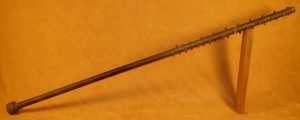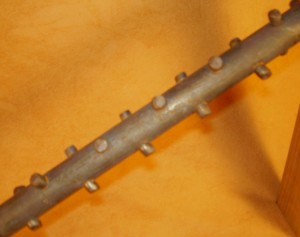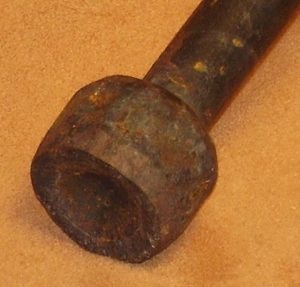 The tetsubo is a fairly obscure but interesting weapon that almost no one had heard of until very recently. Its place in history is a bit sketchy, and it’s difficult to find reliable information on the tetsubo, also called the kanabo, but its place in Japanese mythology is solid. While I know a bit of Japanese terminology as it relates to bladesmithing, I have no real grasp on the language, so unfortunately I’ve had to rely on others and the internet to help get to the truth on this weapon.
The tetsubo is a fairly obscure but interesting weapon that almost no one had heard of until very recently. Its place in history is a bit sketchy, and it’s difficult to find reliable information on the tetsubo, also called the kanabo, but its place in Japanese mythology is solid. While I know a bit of Japanese terminology as it relates to bladesmithing, I have no real grasp on the language, so unfortunately I’ve had to rely on others and the internet to help get to the truth on this weapon.
Fortunately in this case, the language issue is simple and easily found. “Kana” (also spelled “kane”) means metal, and “tetsu” means iron; “bo” means staff or stick. So the tetsubo is an iron staff and the kanabo is a metal staff. Almost all metal staffs were made from iron, so they are really the same thing.
Why then are we seeing brass-studded wooden versions of weapons that were historically made from iron? I’m not certain, but I’ll take an educated guess: there are more wood workers around than bladesmiths and blacksmiths. It’s a simple adaptation that allows cheap and easy production for the uninformed masses. I’m a fan of doing things right. Cheap and easy, not so much, and I’d prefer to inform the masses…
Let’s Press the Issue
 This was a fun project. My son Sam and I had just watched Deadliest Warrior: Viking Vs. Samurai. I was explaining to him that I had read about the tetsubo, and I was pretty sure the producers of the show had gotten it wrong. It probably should have been made of iron or steel because wrought iron is hard to come by these days.
This was a fun project. My son Sam and I had just watched Deadliest Warrior: Viking Vs. Samurai. I was explaining to him that I had read about the tetsubo, and I was pretty sure the producers of the show had gotten it wrong. It probably should have been made of iron or steel because wrought iron is hard to come by these days.
Sam asked if I could make one, and after thinking about it for a half a second, I said “sure, it should be pretty easy.”
I was still trying to source some mild steel round stock of the proper size that wasn’t going to cost me a fortune in shipping when I saw a digging bar in a local big box home improvement store. I got the bar home and sized it up. I cut off the digging blade on the chop saw, drilled some holes in the shaft, and cut up some 2-inch pieces of smaller round stock. After knocking the smaller stock into the holes, I heated it in the forge and used my 24-ton hydraulic press to forge the pins securely into the holes.
The conical stop at the end of the handle wasn’t looking quite right, so I forged it into a cylinder, also on the press. That’s it—no grinding or heat treating. I think it looks better with the forge scale and rust, and it is mild steel, so no heat treatment needed.
Those Nasty Little Peasants
 There aren’t a lot of historical references to this weapon, so we’ll need to speculate a bit on its place on the battlefield. What was this weapon used for? That’s easy, it was used to smash. We will probably learn more if we ask who it was used on. From the mythological perspective, the tetsubo was used by oni (or Japanese demons), and they used it on everyone and everything. Simple enough—oni don’t follow rules. The samurai, however, followed a code of conduct. Pretty strict rules governed what weapons a samurai could use on another samurai and how. The tetsubo would not have been allowed for honorable samurai versus samurai combat. But the samurai often fought peasants who resisted their daimyo as well as ninjas, and I’m going to speculate they weren’t bound by many rules about how to fight peasants and probably none at all when it came to ninja.
There aren’t a lot of historical references to this weapon, so we’ll need to speculate a bit on its place on the battlefield. What was this weapon used for? That’s easy, it was used to smash. We will probably learn more if we ask who it was used on. From the mythological perspective, the tetsubo was used by oni (or Japanese demons), and they used it on everyone and everything. Simple enough—oni don’t follow rules. The samurai, however, followed a code of conduct. Pretty strict rules governed what weapons a samurai could use on another samurai and how. The tetsubo would not have been allowed for honorable samurai versus samurai combat. But the samurai often fought peasants who resisted their daimyo as well as ninjas, and I’m going to speculate they weren’t bound by many rules about how to fight peasants and probably none at all when it came to ninja.
Given the choice between risking damage to very expensive katana, yari, or naginata, and using the inexpensive, impossible-to-break, and easy-to-replace tetsubo, which do you think the noble samurai used on the ragged masses?
I think we can say with a high degree of certainty many an unfortunate villager died under the crushing power of the tetsubo.
An In Dis Corner… Da… Crusher!
The tetsubo pictured is 48 inches long and weighs just over 11 lb. Sam and I took it out for a test ride the day after we made it, and because he only weighed about 65 lb., I did the driving. We first headed for the front yard where an old maple was near death. I jabbed at the trunk a couple of times and took some light swings. So far, so good: just some solid thunks without as much feedback into my hands as I expected.
I tried a 360° spin and hit it harder. OK, that hurt—time to try something that would give. A 2×4 across saw horses: no significant resistance and lots of toothpicks. Concrete patio block, stone dust. Two patio blocks, even more stone dust. Red brick, no problem.
It crushes, it smashes, and it’s a wrecker. But it’s really heavy, and it’s really hard to control. The angular momentum and centrifugal force are incredible. Once this monster is moving it isn’t going to stop easily. You could let it slow on its own, but that will take a second or two. You could forcibly stop it, but when I experimented with this, I felt the connective tissue in my shoulders stretching more than I care for, so I let it spin down on its own. The last option is to let it hit whatever is in the way; if that’s the intended target, fine, but what if a friendly steps in the way? Someone is gonna get hurt. If someone in your party carries this, once in a while there will be an unintended target, especially with full or multiple rotation cavern clearing swings.
Ok, I Promised…
In the comments that came after Real Steel: The Bearded Axe, I promised some cleaving, cutting, smashing pictures in the near future. I’m going to lead off that effort with some tetsubo action video, and I hope to do it soon.
It’s hard to believe that this is already the sixth installment in the series. The readers and kobolds have made me feel at home here, and I appreciate it. Thank you!

Fabulous stuff! My favorite series on Kobold. :)
An underappreciated weapon given the respect it deserves. Nicely done.
Can you wield the tetsubo one-handed? Because I imagine that Japanese peasants are more easily smashed from horseback :-)
Just letting the tetsubo fall under its own weight should do the trick (pain, broken bones, death), atleast I imagine it would.
And I was just talking about Tetsubo’s to a fellow gamer the other week. Great article.
I’m guessing that arm fatigue wasn’t a big issue with this beast. It might of been more terrifying than practical. I would run like hell if I saw someone swinging one of these. Nicely done BTW.
@Sigfried Trent – Wow, That’s high praise considering the quality of writing here on KQ, thanks!
@satyre – It’s definitely underappreciated, thank you.
@Darkjoy – Not a chance on one handed, but maybe a smaller version from horseback :)
I did try letting it fall under its own weight – it still hits HARD. But it is an 11 # hunk of steel.
@nermal2097 – We’re hearing more and more about this weapon in popular culture – I think because people like us are talking about it.
@Tom Allman – I think general fatigue could be an issue over time – it’s heavy! “More terrifying than practical” is probably right on the money.
Really cool to see a bit of light shone on a topic that gets a lot more exposure than understanding in the gaming scene. Looking forward to the next one. (And I love that a guy writing for RPGs has his own 24-ton hydraulic press.)
I’m always amazed at how heavy a 2 lb or 3 lb. weapon becomes after less than a minute. Gravity is a bitch, and swinging steel quickly, changing direction, swinging again, stopping it: it’s exhausting.
So I’m skeptical about an 11 pound weapon as more than ceremonial. It’s definitely two-handed and only for big bruisers in short bursts, I’m guessing.
The one-handed version would be a mace, wouldn’t it?
@Charles Ryan – I’m planning a shop tour piece. The press may well be my coolest tool, but there’s more stuff I’d like to share.
@Wolfgang – Many people are surprised how exhausting it is to throw punches at a heavy bag for a few minutes; as you said, a weapon weighing a few pounds will wear you out quickly.
Yes, I think a mace would be the one handed version – at about a 1/4 – 1/3 of the weight. And there were longer handled maces made for use on horseback.
I wonder if the wooden versions were not meant to resolve the weight issues. Also, having studied classical budo for years, I would venture to guess that this weapon was powered more by the legs. I also think that the methodologies would be similar to some of the giant naginatas (I forget their names, but bigger and heavier) which required full body mechanics.
I blame ‘Crouching Tiger, Hidden Dragon’ for these beauties working their way into Western interests. A very pretty one was used therein to smash the crap out of pretty much everything for at least one fight scene.
@Joe – Regardless of the intention the wooden versions do resolve the weight issues – making them both easier to make and more practical to use. Using ones core strength and legs definitely makes it easier to control than trying to do so with just arms and shoulders.
I’m off to research giant naginatas! I’ve seen and handled giant katana (o-dachi or no-dachi), but I’ve never heard of giant naginatas – COOL.
@DoomedPaladin – I don’t remember that… Now I have to go back and watch that movie again!
Also a favourite weapon for Crab Samurai from the Legend of the Five Rings RPG. They are definately big bruisers!
@nermal2097 – LO5R is great stuff, one of my all time favorite book series. I never tried the RPG, though…
When the zombie apocalypse finally arrives, I’m coming to your house!
@shammond42 – And at which time I will work at the forge like a dwarf under the mountain, making blades for the armies of the living, and you, my friend, will be most welcome. :)
fantastic article Tom. You never fail to deliver.
shammond42 – You’re a gamer after my own heart! :)
@Phil Larwood – Hey Phil, call me Todd, I really mean that. :)
Thanks!
This is a bit of a strange thing and only minor but … “tetsubo” in Japanese (鉄棒)means a type of gymnastic sport, as can be seen here:
http://ja.wikipedia.org/wiki/%E9%89%84%E6%A3%92
kanabo doesn’t have a wikipedia entry but is what we take to be “tetsubo” in, for example, the AD&D Oriental Adventures weapon page (which has excellent pictures!) In fact, the Japanese word “tetsu no bo” (鉄の棒) is the correct word for the staff you’re referring to. I checked this with my Japanese gamer-nerd friends and they all said the same thing – there is no such weapon as a “tetsubo,” it’s a type of gymnastics involving a bar.
I take some consolation in that Japanese imports of foreign words can be just as subtly wrong.
@faustusnotes – Now that’s interesting. I’ll bet the meaning of the gymnastics term refers to the metal bar.
There is an English wikipedia entry for tetsubo, and it’s a picture of the weapon:
http://en.wikipedia.org/wiki/File:Kanabo_tetsubo_2.JPG
Japanese isn’t the only language with that problem when it’s exported. I’m not 100% convinced that tetsubo is wrong for the weapon, but like I said, I don’t speak Japanese. There aren’t many books that cover this, but the few I’ve seen call it “tetsubo”, of course, they’re in English, and they could be wrong.
As I’m writing this I’m thinking that “no” or “o” translates to long or large. For example, a longer than normal katana is called an o-katana. A sword tip (kissaki) is called o-kissaki if it’s the longer version, and an o-dachi (or no-dachi) is a really long katana like sword. Tetsu no bo, I’ll wager, translates to “big iron staff” or something close to it.
Is there a reader out there who is truly fluent in Japanese willing to weigh in on this? I’d really hate to be propagating a mistake…
The English wiki is wrong, I think Todd. The “no” in “tetsu no bo” translates as “of” (the nominative, I think). “Tetsu no bo” translates to “Staff of Iron” while “tetsubo” translates to “iron bar.” The wikipedia page you link to translates to “kanasaibo.” My dictionary translates “tetsubo” as “Horizontal bar.”
I think the “o” in “o-katana” means “honorable,” as in “noble sword,” but “no-dachi” seems to mean a very large sword (the “no” means “farm” for no apparent reason). The page for it is here:
http://ja.wikipedia.org/wiki/%E9%87%8E%E5%A4%AA%E5%88%80
I think tetsubo is a mistranslation by the early gaming world.
@faustusnotes – I tried this one:
http://www.freedict.com/onldict/jap.html
I input “Iron” and “stick” and got “tetsu” and “bou”. “Staff” brings back something different, I think because the dictionary is interpreting staff as a group of employees.
I think the problem we’re having is that the words do literally translate to “iron staff” or “iron stick”, but they mean something else in popular usage. I won’t be satisfied until I find a fluent Japanese speaker who is also involved in traditional Budo and thus understands the nuances and evolution of the word(s) involved.
I’m going to blame the martial arts community instead of the gaming community for getting this wrong (if it’s wrong) because the word was in use in the martial arts long before gamers picked up on it.
Don’t get me wrong about your Japanese gamer friends, their opinion is important, but they are seeing it from a gamers and/or popular perspective, and the Japanese Budo and/or smithing community may have a different angle on it. This could certainly be a case where the usage has evolved over time and what was correct decades or centuries ago is no longer correct.
If I find anything to help get to the bottom of this I’ll post it here. If anyone else gets some info, please do the same. :)
The “o-katana” definition does come from Japanese born smiths who understand the subject. So even if the “O” literally translates to honorable, it’s understood to mean “long” in smithing parlance.
Wow! It’s easy to go wrong with this stuff!
@Wolfgang – I may have said this before, but I am often very pleasantly surprises at how mature and calm discussions are on the KQ blog. It’s flame free and I think it reflects well on the community you have created here. Kudos!
Todd, I have had quite a few arguments with Japanese teachers about the “no” in “tetsu no bo” because, just like the “of” in English, it’s hard to explain when it should be used and when it shouldn’t. It’s a subtle word, and easy to mistransliterate – sometimes you can drop it and sometimes you can’t. And yeah, I wouldn’t be surprised at mistranslations in the martial arts scene!
Lest we take ourselves too seriously, I present the Tetsubo clothes hanging system:
http://item.rakuten.co.jp/amanoi/miya006/
Which we can plainly see is a horizontal metal bar…
Oops! Sorry Todd!
That’s what I get for typing and eating at the same time.
Many is the ninja whose career ended when he was beaten to death with a rakuten clothes hanger. The only thing worse is to be found cocooned inside a futon drier…
@Phil Larwood – can’t blame a fella fer havin’ a sammich.
:)
@faustusnotes – Please pipe in often; I love to learn.
Ahh the Stick. Mr. Fishy is an advocate of the “Stick”.
Oh, and just piping up to say I would LOVE to see that tetsubo video, even in unedited, raw, smash-tastic form.
@Mr. Fishy <– Makes me uneasy with the 3rd person thing… :)
@Wolfgang – I'm limited to cell phone video right now, but I'm planning to put something together this weekend.